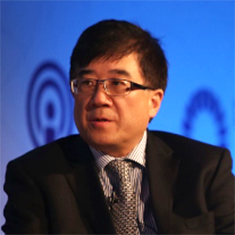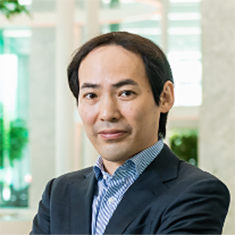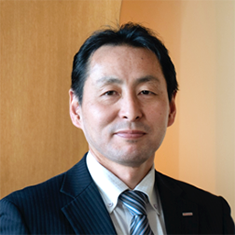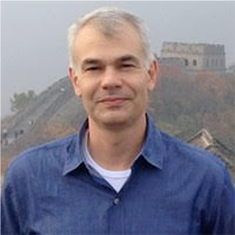*Times in Japanese time, UTC +9 hours
Keynote 01: Centimeter Wave Spectrum for 6G
Tuesday 13 September, 9:30-10:15 (UTC +9)
Abstract
In this talk, we present the development of massive MIMO antenna technologies for the 5G and associated challenges. The overall system performance and antenna design-choice in terms of spectrum and channel propagation properties are discussed. In particular. The novel massive MIMO antenna design to achieve higher capacity with same antenna aperture size and the field trial results are presented. We explore the centimeter wave spectrum for 6G, and the next generation of massive MIMO. The candidate frequency range is from 7GHz to 15GHz, we discuss the new propagation properties and ultra-large antenna element array architecture for both base-station and user-equipment. The 6G centimeter-wave MIMO signal processing represents the new opportunities and challenges to advance the classical MIMO technology.
Wen Tong (CTO, Wireless Network, Huawei Technologies Co., Ltd.)
Dr. Wen Tong is the CTO, Huawei Wireless. He is the head of Huawei wireless research. In 2011, Dr. Tong was appointed the Head of Communications Technologies Labs of Huawei, currently, he is the Huawei 5G chief scientist and led Huawei’s 10-year-long 5G wireless technologies research and development.
Prior to joining Huawei in 2009, Dr. Tong was the Nortel Fellow and head of the Network Technology Labs at Nortel. He joined the Wireless Technology Labs at Bell Northern Research in 1995 in Canada.
Dr. Tong is the industry recognized leader in invention of advanced wireless technologies, Dr. Tong was elected as a Huawei Fellow and an IEEE Fellow. He was the recipient of IEEE Communications Society Industry Innovation Award in 2014, and IEEE Communications Society Distinguished Industry Leader Award for “pioneering technical contributions and leadership in the mobile communications industry and innovation in 5G mobile communications technology” in 2018. He is also the recipient of R.A. Fessenden Medal. For the past three decades, he had pioneered fundamental technologies from 1G to 5G wireless with more than 530 awarded US patents.
Dr. Tong is a Fellow of Canadian Academy of Engineering, and he serves as Board of Director of Wi-Fi Alliance.
Keynote 02: Understanding 6G Modulation to Mitigate Doubly Dispersive Channels – OTFS and Alternatives
Tuesday 13 September, 17:15-18:00 (UTC +9)
Abstract
Due to an increase in bandwidth as well as carrier frequency, mobile communications channels can become doubly dispersive, i.e. in time and in frequency. The increase in carrier frequency at constant velocities of mobile terminals also reduces the coherence time. This results in possibly reducing the chance of acquiring channel state information at the transmitter, and therefore using precoding techniques. Given these boundary conditions a modulation technique is to be found that is robust against doubly dispersive channels for transmitters without channel state information.
For this case, OTFS has been proposed, as it spreads information over time as well as over frequency. It therefore provides the resilience that is searched for. However, it is only a special case. This talk wants to show the general concept of creating the searched robustness, and some specially interesting alternatives to OTFS.
Gerhard P. Fettweis (Vodafone Chair Professor, Technische Universität Dresden & CEO, Barkhausen Institute)
Gerhard P. Fettweis, F’09, earned a Ph.D. under H. Meyr at RWTH Aachen in 1990. After a postdoc at IBM Research, San Jose, he joined TCSI, Berkeley, USA. Since 1994 he is Vodafone Chair Professor at Technische Universität Dresden, Germany. Since 2018 he is also founding research director & CEO of the Barkhausen Institute. 2019 he was elected into the DFG Senate (German Research Foundation). He researches wireless transmission and chip design, coordinates 5G++Lab Germany, spun-out 17 tech and 3 non-tech startups, and is member of the German Academy of Sciences (Leopoldina), and German Academy of Engineering (acatech).
Keynote 03: The Significance of Private 5G in the Entertainment Field
Wednesday 14 September, 10:45-11:30 (UTC +9)
Abstract
Sony Group’s ambition is to change the entertainment industry with Private 5G. There is a growing need in the manufacturing industry, one of the major business areas of Sony Group, to improve production efficiency by introducing advanced digital tools such as IoT and AI over reliable telecommunication infrastructure. Among various types of telecommunications, wireless communication technology is especially useful in factories since production line changes and equipment reallocations occur frequently. The 5G wireless technology, characterized by Ultra-high Bandwidth (eMBB), Ultra Reliable Low Latency Communication (URLLC), and massive Machine Type Communications (mMTC), is expected to bring further changes in the manufacturing industry. Private 5G in particular is promising as communication bandwidth is secured. It is expected that in the future the manufacturing business will expand its scope into areas of virtual production in addition to the existing physical production, as we see growing attention to areas such as metaverse and digital twins. Such shift will start in the entertainment field, such as content creation and gaming. The process of producing entertainment content is similar to those in the manufacturing field as creation, editing and distribution take place simultaneously. The process here is ‘Inside the large production studio, many staffs use different devices at the same time, then the edited content is sent and received between devices, and final outputs created is delivered to end users in real-time”. Therefore, we believe the entertainment field has a high affinity with Private 5G. In this speech, I will talk about how Private 5G will positively impact the production operation side of the entertainment field, and how Sony Group, which runs multiple lines of entertainment businesses, will take on the challenge of such transformation.
Jun Watanabe (CEO, Sony Wireless Communications Inc., CEO, Sony Network Communications Inc.)
Jun Watanabe is the President of Sony Wireless Communication Inc. and Sony Network Communications Inc., both of which are responsible for the telecommunication sector of Sony Group. Jun has more than 20 years of experience in telecommunications. He initiated the Private 5G services for residents in Japan at Sony Wireless Communications Inc. and has pioneered the potential of the 5G business. He also leads the new value creation in the entertainment domain by collaborating with Sony Groups through 5G business. He intends to develop 5G solution services more broadly by making the most of expertise in telecommunications and the assets of the Sony Group.
Alongside, Jun led the launch of “NURO”, the pioneer of high-speed fiber-optic internet service in Japan. He has brought its expansion and the best customer satisfaction in Japan. With the speed and quality highly praised by J.D Power, NURO has grown rapidly, reaching one million customers, including enterprises and residences, in September 2021. He also evolved NURO as a brand providing innovative network services consisting of fixed broadband, mobile broadband, IoT, and AI. Jun is seeking a broadband career as no one has ever seen before by building infrastructure working for and supporting ever-changing consumers and enterprises.
Keynote 04: 5G Evolution and 6G Powered by IOWN
Wednesday 14 September, 17:15-18:00 (UTC +9)
Abstract
Study, development and standardization for technologies toward the evolution of 5G are ongoing, taking into account issues in early 5G services and emerging market needs. In parallel, research focused on technologies and services for 6G is accelerating throughout the world. NTT DOCOMO is very aggressive for 5G Evolution and 6G. And NTT group is promoting IOWN, Innovative Optical and Wireless Network. Both of 6G and IOWN are targeting common future communication society in 2030s. In this presentation, I will explain our vision and latest activities for 5G Evolution and 6G powered by IOWN.
Takehiro Nakamura (Chief Technology Architect, NTT DOCOMO, Inc.)
Mr. Takehiro Nakamura joined NTT Laboratories in 1990. He is now Chief Technology Architect in NTT DOCOMO, Inc. Mr. Nakamura has been engaged in R&D and the standardization activities for advanced radio and network technologies of W-CDMA, HSPA, LTE/LTE-Advanced, 5G and 6G. He has been the Acting Chairman of Strategy & Planning Committee of 5G Mobile Communications Promotion Forum(5GMF) since October 2014 and the leader of White Paper Subcommittee in Beyond 5G Promotion Consortium in Japan since February 2021.
Mr. Nakamura has also been contributing to standardization activities in 3GPP since 1999, including as chairman of 3GPP TSG-RAN from April 2009 to March 2013.
Keynote 05: New Visual Inspection Demands on Indoor Wireless Networks
Thursday 15 September, 08:45-09:30 (UTC +9)
Abstract
Visual inspection and monitoring systems are being deployed at a rapid rate in a number of settings, including manufacturing plants, warehouses, office buildings, retail stores, hospitals and homes and generate a large amount of image, video, and 3D point cloud information. While many sources of such data are directly wired to infrastructure networks, the need for mobile platforms that capture imagery in the same settings also has increased demand on wireless links. The need will only grow as humans and autonomous systems collaborate on a larger scale in dynamic environments. In addition, the consumers of the data are now less often humans monitoring screens and more often learning algorithms whose performance is adversely impacted by typical image and video compression artifacts. Finally, while more computation is now being performed at network edges due to advances in computer architecture and silicon process technology, many applications such as identifying items, validating proper implementation of workflows or path planning in active workspaces require access to large amounts of previously-acquired information, necessitating a prohibitive amount of storage at the edge nodes. Inevitably, large amounts of imagery will be transmitted back to remote servers and storage in the cloud. Applications with real timing deadlines including control and coordination of autonomous lifts in warehouses, workplace safety monitoring, fall detection, automated check-out, interactive games and many more will drive bandwidth demand and latency limits.
Jason Trachewsky (CEO, Aquifi, Inc.)
Jason Trachewsky is the Chief Executive Officer of Aquifi, Inc., a provider of networked material inspection solutions using 3D cameras. Prior to Aquifi, Jason was the Chief Operating Officer and a key technology developer at Passif Semiconductor, a VC-backed startup developing extremely low-power wireless transceivers for portable devices. Passif Semiconductor was acquired by Apple, Inc. in April 2013. Jason came to Passif Semiconductor from Broadcom Corporation, where he co-founded and spent 11 years leading engineering for the WiFi Business Unit as well as contributing to the development of the IEEE 802.11n and 802.11ad standards. Jason entered Broadcom through its acquisition of Epigram, a VC-backed developer of home networking integrated circuits, in May 1999. Jason has authored over 100 patents and received his BSEE from Stanford University.
Keynote 06: User-Centric Network toward Beyond 5G/6G
Thursday 15 September, 16:30-17:15 (UTC +9)
Abstract
Beyond 5G/6G, which will be commercialized around year 2030, is expected to play a crucial role for not only new entertainments using XR in Metaverse for instance but also bringing new lifestyles with various kinds of cutting edge technologies such as humanoid robots and flying cars. Then, it is obvious that Beyond 5G/6G needs to play an essential role for connecting various objects that require a certain level of communication performance depending on applications and use cases.
This talk will firstly introduce use cases in Beyond 5G/6G era, which include outcomes from new lifestyle researches as well as use cases considering existing issues and future dreams from various industries, which are described in Beyond 5G/6G white paper from KDDI and Beyond 5G White Paper published by Beyond 5G Promotion Consortium, Japan, respectively. Then, a new concept named User-Centric Network, which aims at guaranteeing wireless communication performances required by applications and users, will be introduced as well as various technologies comprising User-Centric Network such as Cell-free massive MIMO with clustering techniques, a new concept named “Virtual user terminals,” reconfigurable intelligent surface (RIS) using liquid crystal meta-surface reflector, Radio over Fiber technologies with intermediate frequency multiplexing, and so on.
Satoshi Konishi (EVP and Head of Advanced Technology Laboratories, KDDI Research Inc., VP of Technology Strategy Division, KDDI Corp.)
Satoshi KONISHI joined KDDI in 1993. Since then, he was mainly involved in research and development in wireless communication systems such as LEO satellite systems, mesh-type fixed wireless access (FWA) systems, and mobile cellular systems. He led development of base stations for LTE in KDDI while contributing for standardizations in 3GPP, 3GPP2 and ITU-R. He also realized development and commercialization of new features such as carrier aggregation, Voice over LTE (VoLTE), Femto cell, and so on for the LTE-Advanced system in KDDI since 2014 as Head of Mobile Access Technology Division in KDDI.
He then conducted numerous demonstrations using 5G and 5G commercialization in KDDI since 2017 as Head of Next Generation Network Development Division in KDDI.
Since April 2020, he has been leading B5G/6G as Head of Advanced Technology Laboratories of KDDI Research Inc. as well as leading Beyond 5G white paper by Beyond 5G promotion consortium in Japan.
He received M.S. degree in Electronic Engineering from the University of Electro-Communications (UEC), Ph.D. degree from Waseda University, and MBA degree from Globis University in 1993, 2006, and 2017, respectively.








